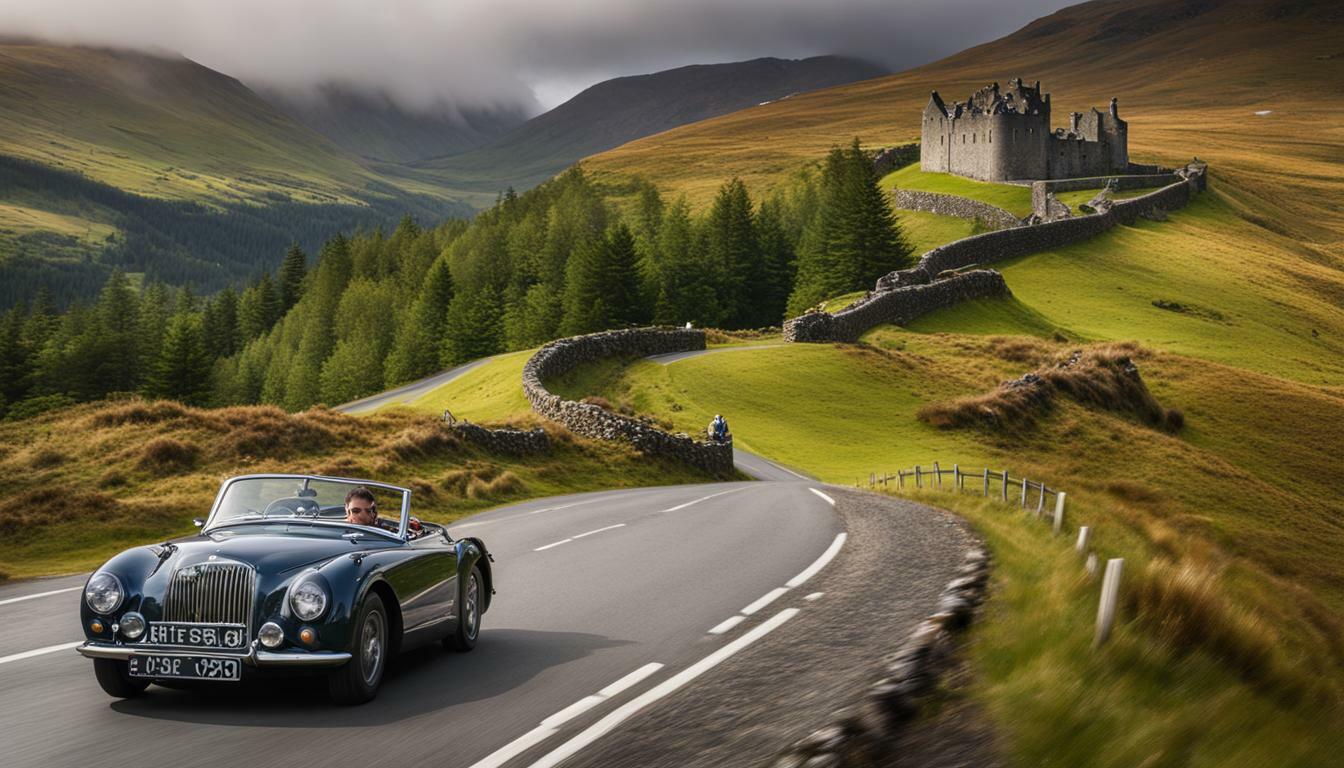Driving in Scotland as an American
Driving in Scotland as an American can be an exciting adventure, but it's important to familiarize yourself with the driving rules in this beautiful country. With some preparation and caution, you can have a safe and enjoyable experience behind the wheel.
Key Takeaways:
- Rent a car to explore off-the-beaten-path locations unless you plan to stay in major cities.
- Choose a smaller vehicle and opt for an automatic transmission if you're not comfortable with manual transmission.
- Expect to pay around $75-100 per day for a rental car, similar to prices in the US.
- Driving on the left side of the road in Scotland takes some adjustment, but staying alert and repeating “drive on the left” can help.
- Carry a physical map and make use of smartphone navigation tools.
- Adhere to speed limits, which are posted in miles per hour.
- Be prepared for roundabouts and give way to vehicles coming from the right.
- Drive cautiously and adapt to hazards such as narrow rural roads, wildlife, and changing weather conditions.
Renting a Car in Scotland
Renting a car in Scotland is the best way to explore the picturesque landscapes, and as an American, there are a few important things to keep in mind to make your experience smooth and hassle-free. When renting a car, choose a smaller vehicle that is easier to maneuver on narrow and winding Scottish roads. Additionally, consider opting for an automatic transmission if you're not comfortable with manual transmission.
The rental prices in Scotland are similar to those in the United States, with an average cost of $75-100 per day. It's advisable to book your car rental in advance to secure the best rates and availability. Most rental companies require a valid American driver's license and a credit card to complete the rental process.
Driving on the left side of the road and the right side of the vehicle can take some adjustment, but with patience and practice, it becomes second nature. Remember to always keep to the left, and repeating the mantra “drive on the left” can help reinforce this habit. It's also recommended to have a physical map of Scotland to supplement your navigation, as well as using a smartphone with GPS for real-time directions.
| Driving Tips for Americans in Scotland: |
|---|
| Drive on the left side of the road |
| Choose a smaller vehicle |
| Consider renting an automatic transmission |
| Book your car rental in advance |
| Have a physical map of Scotland |
| Use a smartphone for navigation |
It's important to be aware of the speed limits in Scotland, which are posted in miles per hour. Stick to the legal limits, which are generally 30-60 mph on urban and rural roads, and 70 mph on motorways. Be cautious while driving through roundabouts, as they are a common feature of the UK road system. Always give priority to vehicles approaching from the right.
Scottish roads can have unique challenges, such as narrow rural roads and single track roads, especially in remote areas. It's crucial to drive attentively and be prepared for encounters with wildlife, such as deer or sheep. Additionally, the weather in Scotland can be unpredictable, with sudden changes in conditions. Adjust your driving to the weather and road conditions, and be prepared for rain, fog, or icy surfaces.
By following these driving tips and being aware of the Scottish driving rules, renting a car in Scotland as an American can be a rewarding experience. Take your time, enjoy the breathtaking scenery, and make memories that will last a lifetime.
Driving on the Left Side of the Road
Driving on the left side of the road in Scotland can initially be a bit daunting, especially for American drivers who are accustomed to driving on the right, but with a few precautions and a keen eye, it can be easily managed.
One of the best ways to adapt to driving on the left is to stay focused and remind yourself to “drive on the left” throughout your journey. It can also be helpful to rent a car with an automatic transmission if you're not comfortable with manual transmission, as it allows you to focus more on your positioning on the road.
When navigating roundabouts, which are common in the UK including Scotland, it's important to remember that the vehicles already on the roundabout have the right of way. Give way to vehicles coming from the right and always signal your intentions to avoid any confusion.
| Driving Tips | Scottish Driving Laws |
|---|---|
| Pay attention to road signs and follow speed limits. | Speed limits in Scotland are posted in miles per hour, ranging from 30 mph to 70 mph depending on the road type. |
| Be aware of narrow rural roads and single track roads. | Single track roads are common in rural areas and require good judgement and patience when encountering oncoming traffic. |
| Watch out for wildlife crossing the road. | Scotland is known for its diverse wildlife, including deer, so caution should be exercised, especially in rural areas. |
Lastly, be prepared for changing weather conditions, as Scotland is known for its unpredictable weather. Always check the forecast before setting off on your journey and adapt your driving style accordingly. This includes using headlights in poor visibility and adjusting your speed to suit the conditions.
By following these tips and being aware of Scottish driving laws, you can navigate the roads in Scotland with confidence. So embrace the adventure, enjoy the beautiful scenery, and have a safe and memorable journey on the left side of the road!
Navigational Tools and Tips
Navigating the roads of Scotland as an American driver requires understanding Scottish road signs and having the right tools at your disposal to ensure a smooth journey. Familiarizing yourself with the different road signs is essential for safe and efficient navigation. Here are some common Scottish road signs to keep in mind:
| Sign | Description |
|---|---|
| Priority road sign: Indicates that vehicles on the main road have right of way. | |
| No overtaking sign: Indicates that overtaking is prohibited on the specified stretch of road. | |
| Speed limit sign: Displays the maximum speed limit for the relevant road section. |
In addition to understanding road signs, having a physical map can be a valuable tool for navigation in Scotland. While smartphones offer convenient GPS capabilities, it's always wise to have a backup plan in case of signal loss or technical difficulties. A physical map ensures you stay on track, even in remote areas with limited cell coverage.
When using a smartphone for navigation, it's important to have a reliable mobile data connection. While major cities and towns have good coverage, more rural areas may have weaker signals. Downloading offline maps or using dedicated GPS navigation apps can help minimize any disruptions. Remember to use a hands-free device when using your smartphone while driving to maintain focus on the road.
By understanding Scottish road signs and having the right navigational tools, you can confidently explore the stunning landscapes and historic sites that Scotland has to offer. Take the time to familiarize yourself with the signs and plan your routes in advance. With the right preparation, your road trip through Scotland will be a memorable and enjoyable adventure.
Speed Limits and Road Safety
Staying within the legal speed limits and prioritizing road safety are essential when driving in Scotland as an American, and understanding the driving rules will help ensure a safe and enjoyable trip. Speed limits in Scotland are posted in miles per hour, and it's important to drive within these limits to avoid fines and penalties. The general speed limits on single carriageway roads are 60 miles per hour, while on dual carriageways and motorways, the limit is 70 miles per hour. However, it's important to note that speed limits can vary depending on the specific road and location, so paying attention to the signs is crucial.
When driving in Scotland, it's also important to be aware of other road safety rules and regulations. Seatbelts are mandatory for both the driver and all passengers, and failure to wear them can result in fines. Additionally, driving under the influence of alcohol or drugs is strictly prohibited, with legal limits significantly lower than in the United States. It's always safer to designate a sober driver or use public transportation if you plan on consuming alcohol.
| Speed Limit | Road Type |
|---|---|
| 60 mph | Single carriageway roads |
| 70 mph | Dual carriageways and motorways |
“Driving in Scotland can be a thrilling experience, but it's important to prioritize safety and adhere to the driving rules. Always respect the speed limits and be aware of other road users. Remember, it's better to arrive a little later than to risk your safety.”
Additional Road Safety Tips
- Keep a safe distance from the vehicle in front of you to allow for sudden stops or changes in traffic flow.
- Watch out for pedestrians, cyclists, and motorcyclists, and give them plenty of space on the road.
- Be cautious when driving on narrow rural roads and single track roads, as they can have limited visibility and passing places. Use pull-ins to allow vehicles to pass if necessary.
- Be aware of wildlife, especially in rural areas and national parks. Animals like deer can unexpectedly cross the road, so be prepared to brake safely.
- Adapt to changing weather conditions, especially in Scotland's unpredictable climate. Rain, fog, and snow can make roads slippery and reduce visibility, so adjust your driving accordingly.
By following these driving rules, staying within the speed limits, and practicing caution on the road, you can have a safe and enjoyable experience driving in Scotland as an American.
Navigating Roundabouts and Hazards
While driving in Scotland, encountering roundabouts and various hazards, especially in the breathtaking Highlands, requires understanding the rules and exercising caution to ensure a smooth and safe journey. Roundabouts are a common feature of Scottish roads and can be initially daunting for American drivers. However, once you grasp the concept and follow the rules, navigating roundabouts becomes second nature.
When approaching a roundabout, always give way to vehicles coming from the right. As you approach, take note of the road signs indicating the direction and exit you need to take. Signal your intention clearly to other drivers, indicating whether you are going straight, turning left, or turning right. Remember to keep to the left side of the roundabout and yield to vehicles already on it.
In addition to roundabouts, Scottish roads can present other hazards that require your attention. Many rural roads in Scotland are narrow and may have passing places, especially in remote areas or on single track roads. These passing places allow vehicles traveling in opposite directions to safely pass each other. It is essential to be vigilant and patient, and always be prepared to pull into a passing place to allow oncoming traffic to pass.
Furthermore, be aware of wildlife that may cross the road, particularly in rural areas. Animals like deer can unexpectedly appear, especially during dawn and dusk. Exercise caution and reduce your speed when driving through areas known for wildlife presence. Finally, the weather in Scotland can be unpredictable, with conditions changing rapidly. Keep a close eye on weather forecasts and be prepared to adjust your driving style and speed accordingly to ensure your safety on the road.
| Hazards | Tips |
|---|---|
| Roundabouts | Give way to vehicles from the right, indicate your intentions, and keep to the left side. |
| Narrow Rural Roads | Be prepared to use passing places to allow oncoming traffic to pass. |
| Wildlife | Exercise caution and reduce speed when driving through areas known for wildlife presence. |
| Changing Weather Conditions | Stay updated on weather forecasts and adapt your driving style to the conditions. |
Adapting to Changing Road Conditions
Scotland's ever-changing weather conditions require American drivers to be adaptable and prepared, as understanding how to handle different road conditions will make your journey safer and more enjoyable. When embarking on a road trip in Scotland, it's important to keep a few driving tips in mind:
- Check the weather forecast: Scottish weather can be unpredictable, so it's a good idea to check the weather forecast before you start your journey. This will give you an idea of what to expect and allow you to plan accordingly.
- Be cautious in wet and windy conditions: Rain and strong winds are common in Scotland, especially in the Highlands. Reduce your speed and increase the distance between your car and the vehicle in front of you to ensure safe braking and maneuvering.
- Watch out for icy roads: In colder months, road surfaces can become icy, particularly in rural areas. Drive at slower speeds and be cautious when approaching bends and hills, as these areas are more prone to ice formation.
Remember, it's always better to be safe than sorry. If road conditions become too treacherous, consider postponing your journey or finding an alternative route. Your safety should always be the top priority.
| Road Condition | Tips for Handling |
|---|---|
| Wet roads | Reduce speed and increase braking distance |
| Windy conditions | Maintain a firm grip on the steering wheel and be prepared for sudden gusts |
| Icy roads | Drive at slower speeds and avoid sudden braking or acceleration |
“The key to navigating Scotland's changing road conditions is to be prepared and exercise caution. Plan ahead, adjust your driving style, and always prioritize your safety.”
Conclusion
As an American driver in Scotland, it's important to familiarize yourself with the driving rules and tips specific to the country. By renting the right vehicle, adapting to the left-hand driving, and being aware of the unique road conditions and hazards, you can have a memorable and safe road trip. Remember to stay vigilant, obey speed limits, and always prioritize safety. So buckle up, get ready to explore Scotland's stunning landscapes, and enjoy the adventure of driving on Scotland's roads!
Conclusion
Embarking on a road trip in Scotland as an American driver offers breathtaking scenery and unforgettable experiences, and with the right preparation and awareness, you can navigate the roads of this enchanting country with confidence and ease.
When planning your trip, renting a car is highly recommended, especially if you want to venture off the beaten path. Opt for a smaller vehicle and consider an automatic transmission if you're not comfortable with manual. Rental prices are similar to the US, averaging around $75-100 per day.
Driving on the left side of the road and the right side of the vehicle may take some getting used to, but staying alert and repeating “drive on the left” can help you navigate this change. Utilize both a physical map and a smartphone for navigation, as this will ensure you stay on the right track.
Remember to adhere to speed limits, which are posted in miles per hour in Scotland. Familiarize yourself with roundabouts, as they are common in the UK, and always give way to vehicles coming from the right. Be aware of potential hazards on Scottish roads, such as narrow rural roads, single track roads, wildlife, and changing weather conditions. Drive cautiously and adapt to the conditions to ensure a safe journey.
Before embarking on your Scottish adventure, ensure you have an international driver's license, as this is a legal requirement. This will allow you to fully enjoy the beauty of Scotland's landscapes and take in the magical sights at your own pace.
FAQ
Is it recommended to rent a car when driving in Scotland as an American?
Yes, renting a car is recommended unless you plan to stay in major cities. It allows you to explore off-the-beaten-path locations and have more flexibility in your itinerary.
What type of car should I choose when renting in Scotland?
It is recommended to choose a smaller vehicle, and if you're not comfortable with manual transmission, opt for an automatic transmission.
How much does it cost to rent a car in Scotland?
Rental car prices in Scotland are similar to the US, with an average cost of $75-100 per day.
How can I adjust to driving on the left side of the road in Scotland?
To adjust to driving on the left side of the road in Scotland, pay attention and repeat “drive on the left” as a reminder. It may take some time to get used to, but with caution, it can become second nature.
What navigational tools are helpful when driving in Scotland?
It is helpful to have a physical map for navigation, as well as using a smartphone for GPS guidance.
What are the speed limits in Scotland?
Speed limits in Scotland are posted in miles per hour. It is important to drive within the legal limits and adhere to the speed restrictions on different types of roads.
Are roundabouts common in Scotland?
Yes, roundabouts are common in Scotland, as they are in the rest of the UK. It's important to be familiar with their rules and give way to vehicles coming from the right.
What hazards should I be aware of when driving in Scotland?
Scottish roads can have hazards such as narrow rural roads, single track roads, wildlife, and changing weather conditions. It's important to drive cautiously and adapt to the conditions.



